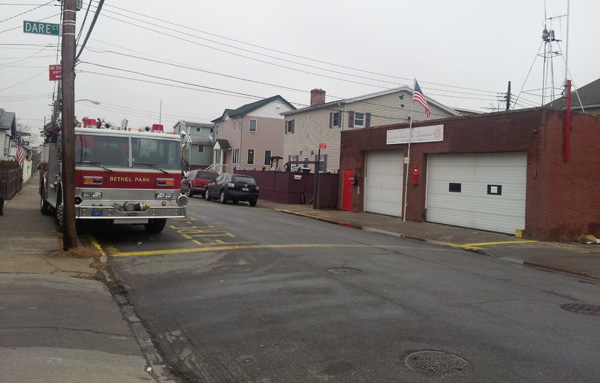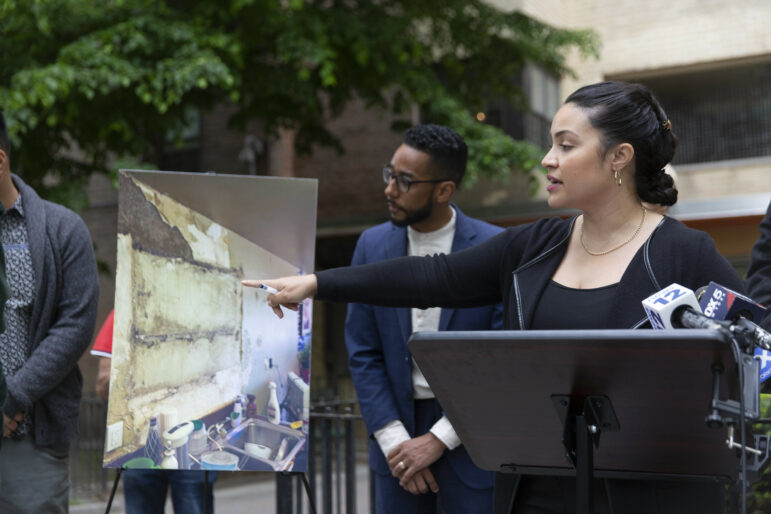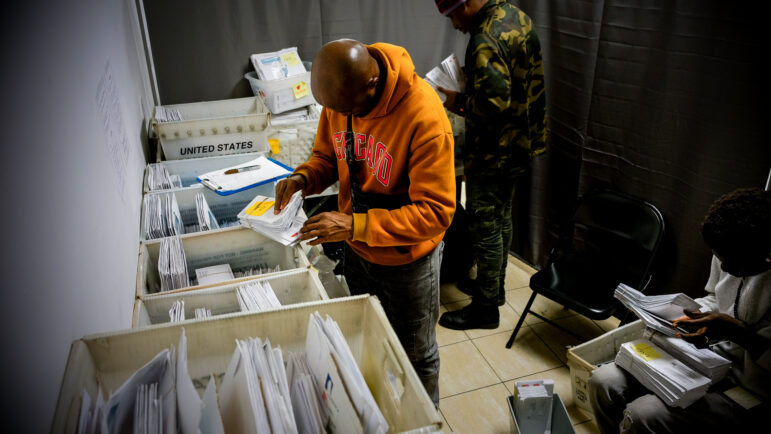
Photo by: Batya Ungar-Sargon
The volunteer fire department in Gerritsen Beach has been a center for relief activity since the storm.
Hurricane Sandy devastated Gerritsen Beach with floodwaters of up to eight feet in some instances. Residents say that 90 percent of the community has been affected by the storm, but some estimates are even higher. Many residents who were in their homes when the storm hit were evacuated by the Vollies—the volunteer Fire Department—to Resurrection Church where they set up cots.
“Without the volunteers and the neighbors, people would be lost,” Pat Trivelli, a volunteer in her fifties, says.
In the early days after Sandy struck, the complaint in neighborhoods like Gerritsen was that government was all but invisible. Now, seven weeks later, federal and city programs are active in the neighborhoods—but there is still frustration over what they’re doing, what they’re not and how long it’s taking.
A quiet corner of Brooklyn
Gerritsen Beach lies in Brooklyn’s southeast corner between Marine Park and Plumb Beach Channel. Enclosed on three sides by water, the neighborhood looks more like a fishing village than like South Brooklyn, with boats bobbing along the channel visible from many points between the houses on the quiet streets. The homes are mostly one or two story single-family residences with big dogs in the yards and boats on trailers in the driveways. The neighborhood boasts Brooklyn’s last volunteer Fire Department.
The population of this blue-collar stronghold is roughly 5,000—95 percent white. The neighborhood has two churches, one Catholic and one Lutheran. It is a very close-knit community, mostly of civil servants, many of who have lived in the neighborhood, which was once a summer resort, all their lives.
Many residents are still homeless due to the damage sustained from flooding. Members of the National Guard, having finished at Breezy Point, are now going door-to-door, bringing medications and periodically evacuating those still in need of it.
Bill Tanger, FEMA Spokesperson and Governmental Affairs Officer for Brooklyn, says that the city’s newest program, “Rapid Repairs,” was designed to provide help to neighborhoods, block by block, instead of by going down a list of those who had applied. Rapid Repairs contractors work in teams of electricians, plumbers and carpenters with the aim of repairing all damage at once.
“People would see contractors going to the neighbors, and they would ask, when are you coming to us?” Tanger explains. “So now the city sends teams to a neighborhood. They are sending 150 teams to Gerritsen Beach.”
How rapid is ‘Rapid’?
But though residents of Gerritsen Beach had seen the contractors around, many felt that they were not adequately servicing the community. “Rapid Repairs?” Trivelli asks skeptically, referring to the city’s program. “We call them Not-So-Rapid Repairs.” Trivelli is trying to help a friend, a 90-year-old woman who has been forced from her home. She is still waiting for any kind of assistance.
Robert Dewitt, a 69 year old man in overalls, lives at the southernmost tip of the peninsula in a house he built himself when he was 25. He has lived in Gerritsen Beach all his life.
“I used to have a sailboat with a thirty-foot mast,” he says with a mischievous smile. “I haven’t seen it since the storm.” Someone did however bring his son’s boat back, though their dock is gone. He points to a canoe lying overturned next to his house. “I don’t know whose that is.” He is retired now, but he used to work for the Department of Environmental Protection. Before that he was a carpenter, and he is restoring his house on his own, which sustained flooding up to his waist. When asked about Rapid Repairs, he says, “They’ve been here. They wrote some things down.”
Dan Ene, Captain of Ambulance for the Vollies, is also the owner of Enewhere Industries, a small business that sells canvas and upholstery for boats. His business was flooded during the storm, and he applied to SBA for a loan. He was rejected twice because of his credit score. His home, too, was ravaged by floodwater. He says Rapid Repairs have been in and out. He called once and never heard back, so he called again. They came after a month to assess the damage to his home, but he says he can’t wait any longer, and has begun renovations himself.
Credit scores a factor
Doreen Carson, a real-estate broker and chief of the volunteers, expresses frustration with federal and city aid. “There are just so many contractors involved,” she explains. “One asks the questions. One files the reports. One looks at the house, et cetera.”
Carson has also lived her whole life in the neighborhood. Her mother bought what had been a summer home for $3,000, and Carson grew up with Dewitt and others who still live in the neighborhood. She owns four business properties; she and her husband work out of two of them, and she rents the other two. “This was supposed to be my retirement,” she says of the rented space, “But they can’t pay me rent right now. Of course they can’t—they’re closed—how can I ask it of them? But I still have to pay the mortgage.”
Federal and city aid is designed, at least in theory, to blot out some of the red ink people like Carson are facing.
A two-year loan is offered by the city’s Small Business Solutions or SBS. It is meant as a bridge loan that businesses or homeowners will then pay back with a loan from the federal Small Business Association, of SBA. SBA has approved over 2,000 loans, but most of these have gone to home-owners, who are encouraged by FEMA to apply, spokesperson Alana Chavez reports. The loans are come with interest rate of 4 percent, repayable over a 30-year period. Chavez says that SBA will ascertain whether their loan is repayable by the applicant, based on income, debt and credit history. If they are denied, they will be sent back to FEMA for a grant.
But Carson says she is still waiting to hear back from SBA, and SBS has flat out denied her request. “There is great disappointment,” she says sadly. “What hurts people the most is that you think your government is going to help you. And then, they offer you a pebble on the beach.” She sighs. “It’s just so sad that people aren’t going to be in their homes for the holidays.”
‘A Little Bit Better’
During the storm, Ene evacuated his family, sensing that the Vollies would be needed to assist others in the community. He was right. They responded to rescue calls of many people trapped in homes, evacuating them to Resurrection Church. “The response to our needs has been… chaotic,” he says. “Government response has been pretty slow.”
So the neighborhood has been compensating. The Fire Department is open for three meals a day. Piles of clothes and blankets are available to any who need them.
“I keep asking FEMA for trailers,” Ene says. “People need hot showers. They are still living in tents. I heard they have heated trailers. We have the park, we could put trailers there. But they don’t respond to me, not the Mayor and not FEMA. I don’t know why.”
FEMA representative Don Caetano says that FEMA is not using trailers in New York City. Rather, they are focusing on trying to get people back into their homes. The only FEMA trailers in Gerritsen Beach will be the service centers along Gerritsen Avenue.
Despite all this, spirits in Gerritsen Beach seem high as members of the community help each other piece their lives back together. In the Vollie’s Training Hall, one day this week volunteers brought supplies in from a truck. Rapid Repairs subcontractors partook of a hot meal with residents still out of a home.
Trivelli works at one of the distribution centers handling the many donations, mostly from individuals and from the police department. A sign reads, “Every Day, a Little Bit Better”.








